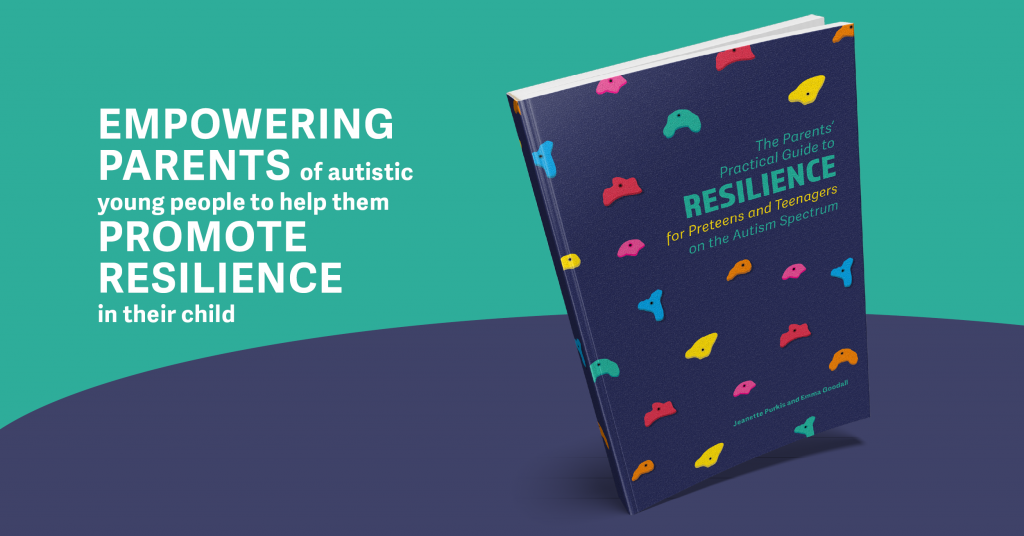Announcing the second book in the Parents’ Practical Guide to Resilience range, authors Jeanette Purkis & Emma Goodall take us through their top tips for older children on the autism spectrum.
Parents of autistic children can understandably worry about their child’s future. When children reach the preteen and teenage years parental concerns can multiply, with things like puberty, dating and moving towards greater independence joining concerns around things like schooling and friendships that parents of younger children may share. Older autistic children and teenagers may find it difficult to manage a life which suddenly involves a lot more complexity.
The teenage years can be confusing, scary and filled with self-doubt and insecurity for all teens. Building resilience and related attributes, such as self-esteem, can make a big difference to autistic young people as they approach key transition points like finishing school and moving into post-school study and/ or employment.
A lack of resilience is sometimes wrongly used as an excuse to blame autistic children and teens for things beyond their control, such as bullying. Even though bullying has nothing to do with resilience, resilience can help the young person being bullied.
Resilience is in fact something autistic preteens and teenagers can benefit from greatly as it helps them address a range of issues that seem to be inherent in autistics; perfectionism, anxiety around change and fear of failing. Resilience is an important element which informs and feeds into an autistic child or young person’s strategies for managing the kinds of challenges which can arise on their journey to adulthood.
To celebrate the release of our new book: The Parents’ Practical Guide to Resilience for Preteens and Teenagers on the Autism Spectrum we have described our five top tips for parents on developing resilience in their autistic child in the preteen and teenage years:
- Accept your autistic child as they are. Focus supports on helping them achieve their potential as autistic people rather than trying to ‘fix’ their autism. You cannot ‘fix’ autism and attempts to do so – such as forcing eye contact or criticising them for ‘stimming’ – are likely to do a lot more harm than good. Start from the position that autism is an integral part of an autistic young person’s character and identity, then building resilience will help them be the best ‘them’ they can be.
- Start from a place of safety. Building resilience needs to start from a solid base. An autistic child or teen needs to have a place they can go to where they feel safe, supported and have some sense of control and agency. Parents can help create this kind of environment for their older child or teen. While this may start in early childhood, it should ideally be carried across as they grow older. A place of safety scaffolds self-esteem and self-confidence and through that helps to build resilience. Most people are more confident when surrounded by people who believe in them and when they have a positive sense of who they are. These things are in themselves a ‘place of safety’.
- Controlled challenges. The key to building resilience for anybody is to face challenges and difficulties and overcome them. The key to building resilience with children and young people – including those on the autism spectrum – is to introduce a series of controlled challenges to help them incrementally take on larger challenges and build their resilience. Controlled challenges can be seen as the engine room of resilience. It can help to view resilience as a muscle that can be developed and grown through the ‘exercise’ of taking on new challenges. Mastering one challenge can build a young person’s strength to take on the next.
- Failing successfully. Being able to fail well is an essential life skill for everyone. Not being traumatised by making a mistake but instead acknowledging it and moving on is a very useful strategy for being able to take on challenges, try new things and learn important lessons. Successful failing is a core element of building resilience and ‘bouncing back’ from setbacks. Failing successfully is a skill that autistic children and teenagers can learn and which will help them build their independence. Being able to fail successfully is a great skill can translate into resilience across all elements of life.
- Boundaries Some autistic teenagers can be rebellious and test parental and other boundaries. Their attitudes towards parents and school can be oppositional even where they had previously been compliant. It is vital to create and maintain appropriate boundaries, even if this is met with anger or opposition. Through setting boundaries and supporting the development of resilience, you are doing your autistic older child or teenager a great service.
The book provides strategies and activities which can support parents of older autistic children and teens to navigate the challenges of their world and through doing so build their resilience and independence in preparation for adulthood.
Find out about the first book, which is for the parents of younger children, The Parents’ Practical Guide to Resilience for Children aged 2-10 on the Autism Spectrum.
If you would like to read more articles like this and get the latest news and offers on our books about autism, why not join our mailing list? We can send information by email or post as you prefer. You may also be interested in liking our Autism, Asperger’s and related conditions Facebook page.
